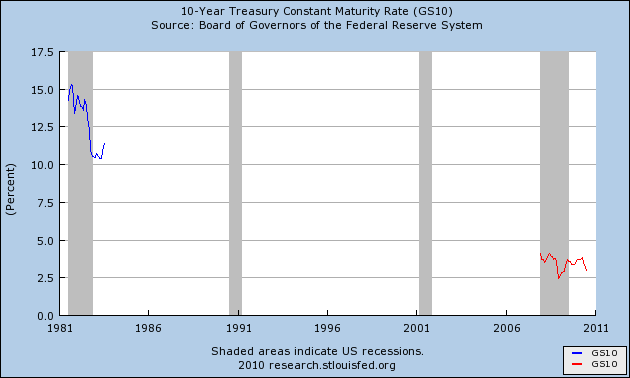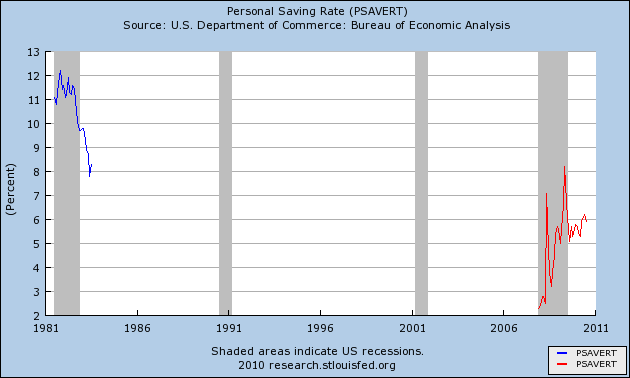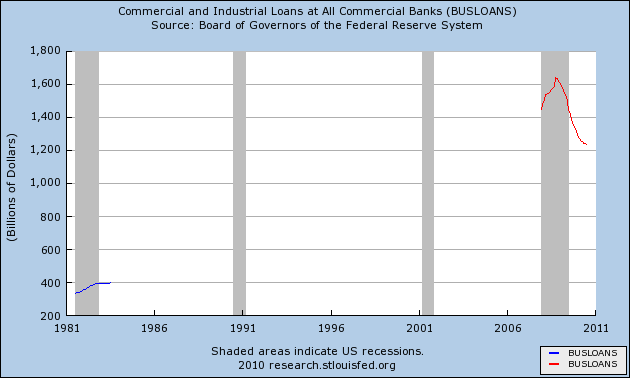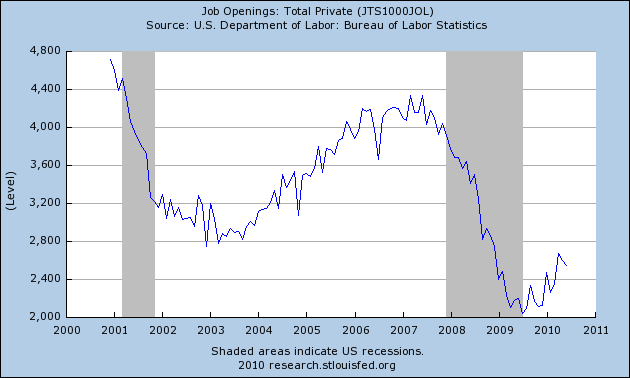To examine the actual data (which I might add is readily available to anyone with an internet connection these days, a fact perhaps Mr. Barro forgets), we can see that this recession is not at all like the 1981 recession and thus taking a direct comparison of long-term unemployment rates is simply wrong.
First, the 1981 recession was caused by the Federal Reserve hiking interest rates in an effort to combat the pervasive inflation of the times. As we can see from the graph below, the 1981 recession began with extremely high interest rates (I use the 10-year rate as a measure here to reflect not only the fed, but market expectations as well), while our current recession not only began with low rates (by historic standards, but also with a huge economic bubble (ie Housing) that did not exist prior to the 1981 recession).

This graph also clearly highlights one of the prime movers of recovery from the 1981 recession, as a dramatic fall in interest rates at the end of the recession was a huge boon to the economy (and thus hiring).
Next, we should examine the savings rate. Back at the beginning of the 1981 recession, savings rates were high (allowing people and the economy to better sustain a job loss sans additional benefits) and when the recession ended, savings fell, again fueling a very sharp recovery.

While today, we can clearly see that the savings rate is on the rise (crimping current spending and current economic growth) and is still well below even the "recovery level" following the 1981 recession's end.
Drawing on Mr. Barro's argument that the 1981 recession = the 2007 recession, we should examine business loans, as these loans would typically indicate both demand/availability of credit to businesses that are looking to expand (or at least maintain current operations) and would have a direct impact on the ability of business to hire those people that would have jobs after 26 weeks had they simply not been lazy Americans.

Why, look at that, a quick examination of actual data shows that during the 1981 recession business loans stayed relatively flat (the uptick at the beginning was likely due to inflation), while during our "identical" recession they have fallen off a cliff. This indicates that businesses either a)do not have the access to credit to grow (ie hire) those lazy unemployed people or b) do not see the demand in the economy for growth (or both). Once again, data seems to indicate that Harvard made a poor decision in hiring Mr. Barro to teach (or "research") economics.
Finally, we can examine the JOLTS (Job Openings and Labor Turnover) data. This is a relatively new data source (it wasn't around during the 1981 recession) and perhaps because it is so new Mr. Barro didn't realize he could look here to back up his assertions. What we can see from JOLTS is that both job openings (private) and job hires (private) are still far below even the bottom levels from the last recession. Which is interesting, because according to Mr. Barro's theory, what we should be seeing are lots of job openings that go unfilled simply because those lazy unemployed don't want to work.

Openings.

Hires.
JOLTS also conveniently examines "quits" (ie people who quit their jobs), which we would expect to be much higher during a period of fantastic unemployment benefits (since you can qualify for UI benefits if you quit because hours were drastically reduced and/or pay was significantly cut), but when we examine the data we see that in fact quits are at a series low:

Once again displaying Mr. Barro's complete lack of even giving the data a cursory look before shooting his mouth (or in this case pen) off.
I think what we can conclude from all this is not necessarily that an extension of unemployment benefits has no impact at all on unemployment rates (but probably less so during such a deep recession like we are now mired in), but simply that Mr. Barro has shown himself to be the champion of the paste eaters and a person completely lacking in professional integrity as an economist.